Posted by Anita on 11.23.07 7:14 AM
 When DPaul asked me to tend bar at Sean‘s birthday cocktail party, I jumped at the chance. All the fun of planning and serving drinks to our friends, but none of the mess? Sign me up! In all honesty, it seemed a simple enough assignment. My only limitations: Neither Sean nor Paul is a fan of gin (something we’re planning on addressing next year), and Sean has a well-known horreur of orange.
When DPaul asked me to tend bar at Sean‘s birthday cocktail party, I jumped at the chance. All the fun of planning and serving drinks to our friends, but none of the mess? Sign me up! In all honesty, it seemed a simple enough assignment. My only limitations: Neither Sean nor Paul is a fan of gin (something we’re planning on addressing next year), and Sean has a well-known horreur of orange.
I wanted to keep things interesting without going overboard — no complicated lists of ingredients to be purchased, schlepped, and mixed. I also wanted drinks that were flavorful but not too strong. Drinking Martinis and Manhattans all night leaves a dreadful impression the next morning, especially for folks who aren’t used to anything stronger than a glass of red wine.
Paging back through a year’s worth of Drinks of the Week, I was astonished by how many were gin based. (Well over half, can you believe it?) Most of those that remained were either seasonally inappropriate, or not suited to serving in quantity. The lone successful candidate was a variation on our own Rosemary Five, tweaked ever so slightly by substituting lemon juice for the original lime. The birthday boy’s a big fan of pears, and the other ingredients are common enough that none of the guests would be spooked.
I wanted another effervescent drink for a second option, but none of the bubbly drinks in our repertoire seemed like a good fit for the occasion. Flipping through cocktail books, I noticed a few mentions of a tipple called the Oh, Henry! — a blend of ginger ale, Benedictine, and Bourbon (or whiskey, in some Continental sources). Mixed in equal proportions as some books suggested, the drink was far too sweet and overpowered by the Benedictine’s spice. But dropping the ratios to 2:2:1 worked perfectly when using a saucy Bourbon and a fiesty ginger ale. (We paired Knob Creek and Blenheim for the party, although Fever-Tree works fine if you prefer a subtler variation.)
If I do say so myself, both drinks were well received. The Oh, Henry!’s bourbon base made it a tougher sell, but I spied a number of folks being converted by a sip of their neighbor’s drink, and coming back for the darker cocktail on their second round. Could this be a gateway drink for the bourbon-averse?
Not surprisingly, this simple mix has become a favorite in our house, too. It’s a perfect autumn-into-winter blend of sugar and spice, with just enough herbal undertones to keep everything grounded. The star anise garnish — stolen from the Falling Leaves — is our own touch, a complementary (and attractive) addition to the drink’s aromatic profile.





Oh, Henry!
1-1/2 oz bourbon
1-1/2 oz ginger ale
3/4 oz Benedictine
Stir all ingredients in an ice-filled mixing glass, and strain into a cocktail glass. Garnish with a piece of star anise, if desired.
Drink of the Week, drinks, holidays & occasions, other blogs, recipes
10 Comments »




Posted by Anita on 11.02.07 8:59 AM
 Dia de Los Muertos, or the Day of the Dead, is a bit of a misnomer, especially in Mexico where the festivities are often spread out over two or more days. Like most Latino holidays of a spiritual sort, this fiesta integrates indigenous traditions alongside Catholic feasts, blending traditional pre-Hispanic ancestor worship with the Europeans’ All Saints Day and All Souls Day. Children and other innocents are remembered on November 1, and those who died as adults are honored the next day and night. As someone for whom death is a relatively fresh memory, setting aside a few days to remember those we have lost seems eminently wise, a useful way of mourning together and acknowledging individual loss as part of a universal experience.
Dia de Los Muertos, or the Day of the Dead, is a bit of a misnomer, especially in Mexico where the festivities are often spread out over two or more days. Like most Latino holidays of a spiritual sort, this fiesta integrates indigenous traditions alongside Catholic feasts, blending traditional pre-Hispanic ancestor worship with the Europeans’ All Saints Day and All Souls Day. Children and other innocents are remembered on November 1, and those who died as adults are honored the next day and night. As someone for whom death is a relatively fresh memory, setting aside a few days to remember those we have lost seems eminently wise, a useful way of mourning together and acknowledging individual loss as part of a universal experience.
The celebration — somehow more intimate and yet more festive than Halloween — gives people time to openly remember their dearly departed, and many Mexican and Mexican-American families erect memorial altars in their homes. These ofrendas typically feature a photo of the deceased surrounded by candles, glasses of water, vases of marigolds, small statues of saints or skeletons, decorated sugar skulls, and plenty of food. In addition to the rich bread known as pan de muerto, altar offerings often include moles or other fragrant dishes, bottles of beer or tequila, and other treats to tempt the spirits of the departed to return for a visit home.
Not far from our house, the streets around 24th and Mission are filled with shoppers stocking their altars: The craft stores sell skeleton figurines and papel picado, the florists put out bunches and buckets of marigolds, the panaderias set up tables of pan de muertos on the sidewalk, and the smell of incense fills the air. The mood is festive and the decorations colorful, and tonight, there’ll be a festive parade through the heart of the Mission. What a civilized way to celebrate life’s ultimate certainty.



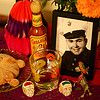

One of the most recognizable symbols of the fiesta is La Calavera de la Catrina, the fancy-lady skeleton. As with many macabre figures in Mexican folk art, La Catrina serves as a reminder that death comes for us all, even the well-to-do and the beautiful. But La Catrina doesn’t let her mortality stand in the way of a good time: She dons her best plumed hat and heads out for a jaunty stroll. Although La Catrina is, herself, dead, she looks so much like a storybook widow-in-black that it’s hard to remember that she’s actually the deceased, not the mourner. No wonder she feels so festive! If you catch her in the right moment, she might just give you a…
Widow’s Kiss
1-1/4 oz Calvados or other apple brandy
3/4 oz Benedictine
3/4 oz yellow Chartreuse
2 dashes aromatic bitters
Stir all ingredients with ice, then strain into a chilled cocktail glass. Garnish with a brandied cherry, or a sugar skull.
Drink of the Week, drinks, holidays & occasions, recipes, The Mission
4 Comments »




Posted by Anita on 08.15.07 12:31 PM
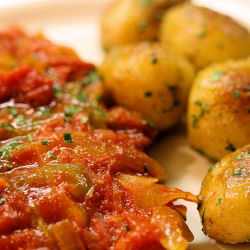 Julie Powell notwithstanding, most cooks discovering Julia Child’s recipes for the first time seem mysteriously drawn to the most labor-intensive and luxurious among them. Apparently, this isn’t strictly a modern phenomenon: In his entertaining book The United States of Arugula, David Kamp recounts this very same thing happening when Child’s first book debuted, poking gentle fun at those who “deliberately chose the most difficult [recipes] to execute when company was coming.”
Julie Powell notwithstanding, most cooks discovering Julia Child’s recipes for the first time seem mysteriously drawn to the most labor-intensive and luxurious among them. Apparently, this isn’t strictly a modern phenomenon: In his entertaining book The United States of Arugula, David Kamp recounts this very same thing happening when Child’s first book debuted, poking gentle fun at those who “deliberately chose the most difficult [recipes] to execute when company was coming.”
Among these over-the-top creations, Kamp makes much of the overwrought dish known as Veau Prince Orloff, “a display piece consumptive of enough time and money to garner status.” I looked up the offending recipe in my own copy of Mastering the Art of French Cooking, and felt a little queasy: The damned thing goes on for three full pages and contains — I kid you not — no less than a dozen sub-recipes.
Luckily for those of us who don’t have days to spend in the kitchen, Julia’s chef d’oeuvre also offers up simple recipes in spades. Scattered among the aspics and the suprêmes and the canard a l’orange lies a wide assortment of bistro classics and a fair number of recipes that rise no higher than the cuisine de bonne femme of everyday French households. Kamp recounts Julia herself choosing the simple potage Parmentier as the book’s first recipe “so that her audience would not be intimdated.”
When I pull out my Grandpa‘s battered copy of Mastering, these are the sorts of recipes I crave: The Provençale garlic soup, the mushroom quiche, the steak au poivre. So when Lisa at Champaign Taste proposed her second-annual blog party to honor the 95th anniversary of Julia’s birth, I knew right away the sort of dish I’d share. Sure, it’s not going to win any beauty contests, but it’s a delicious and satisfying plate full of seasonal flavors with a subtle French flair.
Julia recommends serving this humble “Ham Slices Baked with Tomatoes, Onions and Peppers” alongside her sauteed potatoes — and really, folks, how can you pass that up that kind of good advice? While I prepped the piperade, Cameron peeled a pound of baby spuds and trimmed them to roughly the same size, browned them in butter and oil, then covered them to steam until tender. Along with a bottle of French rosé, they were the perfect foil for the tangy, salty richness of the ham. We raised our glasses to the warbly voiced girl from Pasadena, and counted ourselves truly lucky to have lived in her era.


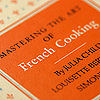
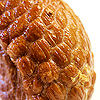
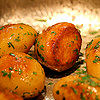
Jambon en Pipérade
– adapted from Mastering the Art of French Cooking
Cook’s note: Julia simply calls for “peeled, seeded, juiced and sliced” tomatoes; I’ve complicated matters a bit by explaining how you get there. If you dispense with peeling your own tomatoes and opt for good quality whole canned tomatoes — like Muir Glen — you’ll need 2-1/2 cups of tomato pulp plus about 3/4 cup of their juice. Go this route and this simple dish can be on the table in less than 45 minutes.
2 pounds cooked ham, sliced 1/2-inch thick
1 to 2 T bacon fat or olive oil
1 cup sliced yellow onions
1 cup sliced green bell peppers
2 pounds firm, ripe, red tomatoes
2 cloves garlic, mashed
1/8 tsp pepper
pinch of cayenne pepper
1/4 tsp fresh thyme
2 T minced parsley
Preheat the oven to 350°. Meanwhile, bring a saucepan of water to a boil.
While the water heats, prepare an ice-water bath in a large bowl. Peel the tomatoes by scoring an ‘x’ in the bottom of each, then dropping into the boiling water. When the skin begins to peel away from the ‘x’, remove from the pan with a slotted spoon, and drop each tomato in the ice-water bath. When cool enough to handle, remove the tomato and peel off the skin. Proceed with the remaining tomatoes until all are peeled.
Cut each tomato in half, and remove any hard core or stem section. Squeeze the juice and seeds out of the fruit, reserving on the edges of the cutting board (or in a bowl if they become overwhelming). Slice the squeezed tomato flesh into regular pieces. Set aside the tomato flesh and the tomato seeds/juice separately.
Trim any excess fat off the ham, and dry each slice on paper towels. Heat the fat in your largest skillet until it is almost smoking; then brown the ham for a minute or two on each side. Remove ham from skillet and place in a shallow baking dish large enough to hold the ham in one layer. (A slight overlap is fine.)
Lower the heat and stir the onion slices into the fat. Cook over medium-low heat for 5 minutes. Stir in the peppers and cook 5 minutes more, or until the vegetables are soft but not browned.
Place the tomato pulp over the onions and pepper, and continue to cook over medium-low heat. While this is happening, scoop the tomato seeds and juice, along with any seed jelly, into a strainer, and add the strained liquid to the skillet.
Push the solids to one side of the pan, and tilt the skillet to allow the liquids to gather on the now-empty half of the pan. Arrange the skillet off-center on the burner so that the juice side of the pan is directly over the flame, and the vegetables are further away. Simmer until the juices become minimal, stirring everything together and re-dividing every few minutes, to make sure that the juices reduce without overcooking the vegetables.
When the tomato juice has almost evaporated, stir it back into the vegetables and cover the browned ham slices with the mixture. Cover the baking pan with foil, and place in the preheated oven. Cook for 20 to 30 minutes, until the ham is heated through and tender. Baste with juices in the dish, then correct seasoning if necessary. Garnish with chopped parsley, and serve with sauteed potatoes.
cookbooks, holidays & occasions, meat, recipes
7 Comments »




Posted by Anita on 06.24.07 8:07 PM
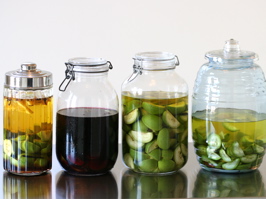 Every June 24, Catholics around the globe celebrate the feast-day of John the Baptist. And every year, on that same day, traditional-minded Europeans head into their local walnut orchards, filling baskets and bags with unripe nuts in order to make nocino, an Italian walnut liqueur, or its French cousin vin de noix.
Every June 24, Catholics around the globe celebrate the feast-day of John the Baptist. And every year, on that same day, traditional-minded Europeans head into their local walnut orchards, filling baskets and bags with unripe nuts in order to make nocino, an Italian walnut liqueur, or its French cousin vin de noix.
We’ve made nocino every summer for the past three years, usually a bit later than the traditional saint’s day due to trouble in our local supply chain. Suffice to say that we lack the necessary ferme, fattoria, or bucolic farmhouse of any sort, and we’ve relied either on nuts shipped from afar or the whimsical schedule of a certain vendor at the Alemany market.
This year, we not only avoided our usual delay, we even jumped the gun a bit. But I hope you’ll agree our motives were good: We were off to Yountville for our anniversary, and I’d remembered reading Shuna’s story last fall about Hoffman Farm, a Napa u-pick with a vast walnut orchard. The idea of making liqueur with nuts we’d plucked ourselves from local trees was simply too attractive to pass up, no matter the date was a tad early.
It took me days to work up the nerve to call John Hoffman and explain what I had in mind. He’d never heard of anyone wanting green walnuts before. “You do know they’re incredibly bitter?” he asked me on the phone. But he graciously allowed that we might stop the coming weekend and pick some nuts, as long as we didn’t come on Sunday morning during church. I assured him that we’d work around his schedule, and would be sure to call before we came, in any case.
Saturday rolled around, bright and sunny. We called Mr. Hoffman to make sure he was home, then donned hats and sunscreen and pointed the car toward Silverado Highway. Just past the intersection with Trancas, we spied the farm’s little sign, a blink-and-miss-it affair. We pulled up the gravel drive and found Mr. Hoffman waiting for us in the shade near his farmhouse garage.
We introduced ourselves and chatted a bit, and he asked me to remind him about what I would do with my early harvest. I explained about splitting the nuts and soaking them in alcohol for most of the summer, then setting aside the strained, sweetened infusion until Christmastime. I marveled that a walnut farmer — and one with Italian in-laws, at that — had never tasted what I’d always assumed was a relatively common homebrew. Not only had he never made it, he’d never even heard of it. Chuckling, he quipped: “Sounds like a waste of a good bottle of vodka,” and winked at Cameron.
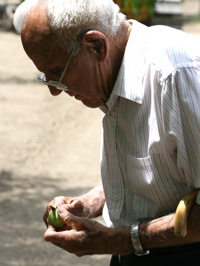 Then he picked up his cane and strolled us out into the orchard. A sun-dappled canopy of walnut boughs stretched as far as the eye could see, all the way back to the crossroads. Mr. Hoffman showed us how to avoid the nuts that suffered from blight — they were few, this early in the season — and how to spy the telltale bore holes of caterpillar infestation. He reached for his pocketknife and cut open one of the few rotten nuts he could find, to show me how the fungus penetrates the hull and works its way to the developing meat.
Then he picked up his cane and strolled us out into the orchard. A sun-dappled canopy of walnut boughs stretched as far as the eye could see, all the way back to the crossroads. Mr. Hoffman showed us how to avoid the nuts that suffered from blight — they were few, this early in the season — and how to spy the telltale bore holes of caterpillar infestation. He reached for his pocketknife and cut open one of the few rotten nuts he could find, to show me how the fungus penetrates the hull and works its way to the developing meat.
It was a botany tutorial, a history lesson, and a glimpse at a disappearing way of life. The Hoffmans have worked this land since the end of World War II. Now, they’re farming one of Napa’s few remaining diversified acreages, as vineyards squeeze out the fruits and nuts that once were the valley’s pride. As Shuna mentions, although the Hoffman land is protected for agricultural use, there’s nothing to prevent these noble trees from being torn out in favor of yet another mass of wine grapes.
After a half hour of picking nuts and snapping photos in the late-morning glow, we brought our canvas sack back to the garage. Mr. Hoffman discussed how to price our unusual transaction while he weighed our haul on his weathered scale. When all was said and done, he refused to take more than a fraction of what we’re used to paying, even when we told him that the going rate was much, much higher. He shook his head like we were citified fools, then added: “You can keep the quarters if you tell me that recipe again.” I smiled broadly and promised to send him prints of the photos we’d taken, plus a few different recipes to try.
We grinned all the way home, amazed at our good fortune in finding Mr. Hoffman — all thanks to Shuna.
After stopping by the local liquor depot for bottles of 100-proof vodka, I quickly set to work halving and quartering the green nuts, measuring sweeteners and spices, and sterilizing my infusing jars. Never had I had the luxury of using nuts picked within hours of infusing, much less 7 pounds worth gathered with my own two hands. Unsurprisingly, we had sufficient nuts for two different batches of nocino — my usual recipe, plus an experiment — as well as a version of Abra’s traditional vin de noix and Lucy’s lighter recipe made with white Burgundy and maple syrup.
I left my quartet of crockery on the new breakfast table for a day or two; they caught the light so beautifully that I wanted to see them (and sneak a sniff of them) all the time. Once the liquids steeped to a black-hole opacity, I followed tradition and put them out in the garden — in this case, the back deck — where they’ll commune with nature for the next 40 days and 40 nights. Then we’ll filter them, bottle them, and wait for the other end of the year, when midwinter brings us yet another celebration of the natural cycle disguised as a religious feast.



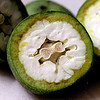

Hoffman Farm
2125 Silverado Trail
Napa, CA 94558
707 226-8938
drinks, holidays & occasions, Italian, locavore, Napa & Sonoma, preserving & infusing
13 Comments »




Posted by Anita on 06.08.07 12:43 PM

We’ll be away from the blog for a few days. We have an occasion to celebrate, and dinner reservations at a special place tonight. (Please forgive the photo — it was the best of the roll from our last visit in 2005!)
I’m stunned to realize that it’s been more than two years since we visited Wine Country. Is it possible we haven’t been back since we left Seattle? That’s almost as hard as it is to believe that it’s been five whole years ago since we were married, just on the other side of the hills in Sonoma County.
Have a great weekend. I know we will!
holidays & occasions, Napa & Sonoma, restaurants
9 Comments »




Posted by Cameron on 04.18.07 9:47 PM
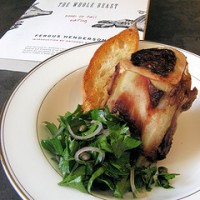 “I got nasty habits, I take tea at three
“I got nasty habits, I take tea at three
Yes and the meat I eat for dinner
Must be hung up for a week”
–“Live With Me,” The Rolling Stones
Quick flashback to five years ago, just before we became legally married with dinner. We relate our honeymoon plans to friends and acquaintances and are met with raised eyebrows and a single repeated question:
“You’re going to England for two weeks? What are you going to eat?”
Everything that we could fit in, thank you very much, and the list was longer than we’d have time or money for. Every Real Ale pub within reach of the Underground. Boxwood Cafe. Pork and stilton breakfast sandwiches from the Borough Market, washed down with Monmouth Coffee. Cheese from Neals Yard Dairy. English breakfast, bangers please. Eton Mess. Branston Pickle. Chip shops. Eccles cakes. Pret a Manger. McVitties. Packaged meals from London groceries as good or better than you could make with fresh ingredients.
 But the meal that I was not-so-secretly looking forward to the most was dinner at St. John Bar and Restaurant. It was food that (at the time) I could only find in England. Every possible part of some ridiculously tasty animal prepared and served practically unadorned. Anita still wakes with a start from dreams of Middlewhite pork. Here I found what I adore about English cuisine: naked love for animal fat, roasted flesh, organ meats, connective tissue, and wild things from the hunt. Pig tails, venison, game birds, sliced roast beef, Yorkshire pudding.
But the meal that I was not-so-secretly looking forward to the most was dinner at St. John Bar and Restaurant. It was food that (at the time) I could only find in England. Every possible part of some ridiculously tasty animal prepared and served practically unadorned. Anita still wakes with a start from dreams of Middlewhite pork. Here I found what I adore about English cuisine: naked love for animal fat, roasted flesh, organ meats, connective tissue, and wild things from the hunt. Pig tails, venison, game birds, sliced roast beef, Yorkshire pudding.
And beef marrow. Have mercy, the beef marrow.
Roast Bone Marrow and Parsley Salad
from The Whole Beast: Nose to Tail Eating, by Fergus Henderson
(note: this recipe captures just a bit of Chef Henderson’s calm, dry voice and humor. The actual cookbook is as entertaining to read as it is to use. Plus, who else is going to tell you how to deep-fry lamb’s brains?)
– serves four
twelve 3-inch pieces of veal marrowbone
a healthy bunch of flat-leaf parsely, leaves picked from the stems
2 shallots, peeled and very thinly sliced
1 modest handful of capers (extra-fine if possible)
Dressing:
juice of 1 lemon
extra-virgin olive oil
a pinch of sea salt and freshly ground pepper
a good supply of toast
coarse salt
Put the marrowbone pieces in an ovenproof frying pan and place in a hot 450 degree (F) oven. The roasting process should take about 20 minutes depending on the thickness of the bone. You are looking for the marrow to be loose and giving, but not melted away, which it will do if left too long (traditionally the ends would be covered to prevent any seepage, but I like the coloring and crispness at the ends).
Lightly chop your parsley, just enough to discipline it, mix it with the shallots and capers, and at the last moment, dress the salad.
Here is a dish that should not be completely seasoned before leaving the kitchen, rendering a last-minute seasoning unnecessary by the actual eater; this, especially in the case of coarse sea salt, gives texture and uplift at the moment of eating. My approach is to scrape the marrow from the bone onto the toast and season with coarse sea salt. Then a pinch of parsley salad on top of this and eat. Of course once you have your pile of bones, salad, toast, and salt it is diner’s choice.
English food is not a joke because nose to tail eating is serious business.
This post is part of the Fish & Quips event hosted by Becks & Posh, in honor of St. George’s Day.
cookbooks, cooking, holidays & occasions, meat, other blogs, recipes, travel
9 Comments »




Posted by Cameron on 04.10.07 4:31 PM
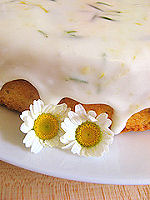 Last Saturday, we enjoyed a pre-Easter dinner with our friends DPaul and Sean and Anita’s mom, Toni. Anita has already described the first course; my contribution was Cornmeal Rosemary Cake with Lemon Glaze from one of our two Tom Douglas cookbooks, Tom’s Big Dinners.
Last Saturday, we enjoyed a pre-Easter dinner with our friends DPaul and Sean and Anita’s mom, Toni. Anita has already described the first course; my contribution was Cornmeal Rosemary Cake with Lemon Glaze from one of our two Tom Douglas cookbooks, Tom’s Big Dinners.
I’m not sure exactly why I ended up making it, as I’m not much of a baker. Anita is usually the head chef in our kitchen, but she was called away to help with the transportation of Sean and DPaul’s new (and absolutely adorable, but indisposed) family member. We needed to get cracking on dinner, but when Toni–who is an accomplished baker–asked to be put to work, I pointed her at the soup, not the cake. Go figure.
The batter assembly went smoothly. Or at least I thought it did until I realized that I had used rough, coarsely ground cornmeal instead of the medium-grind called for by the recipe. I pinched the bridge of my nose and rehearsed stand-up material to explain the…er…crunchy cake. “So rustic, isn’t it?” I imagined myself saying through my best Joy of Cooking smile. “Here, have another large glass of whiskey to wash that down. It’s a family tradition.”
Then, after fifteen minutes of baking, I noticed that while I had set the oven to 350 degrees, the thermometer inside read 325. Great. I turned up the heat.
The baking time recommended by the recipe came and went and I hovered at the oven window. The top started to brown and the cake tester came out clean, but when the cake was lying unmolded and upside down, it was obviously still mushy in the middle. Rummaging through our generous assortment of nonstick cake pans, I said a silent little prayer of thanks for my lovely, brainy wife and her talent for collecting cookware.
I re-panned the cake and shoveled it back in the oven, setting the timer in five-minute increments and wondering how the hell I would know when the damn thing was done. Out of desperation, I fell back on my grill-fu and started poking the cake with my (scrupulously clean) fingers, comparing the center with the edges, which I figured were sufficiently cooked.
Eureka! The top was much browner than I would have dared let it go otherwise, but eventually the cake stopped feeling like a waterbed. Cooled and unmolded, it actually looked edible–after Anita helped re-assemble the chunks that had stuck to the non-stick pan.
But I had the baker’s ace up my sleeve, the magical stuff that hides an epic poem’s worth of sins. I generously brushed on a Meyer lemon syrup (fruits from our tree!) and then took great comfort in watching my missteps and misgivings disappear beneath a dense white robe of sugary glaze speckled with rosemary leaves and lemon zest.
Didn’t taste bad, either. No whiskey necessary.
baking, cookbooks, dessert, family, holidays & occasions
5 Comments »




Posted by Anita on 04.09.07 6:07 PM
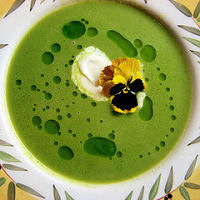 The gorgeous soup we served for Easter-eve supper — as a first course before a tried-and-true potato gratin and a succulent Fatted Calf Petit Jamon — is an old Soup of the Fortnight favorite. But last time I wrote about it, I only linked to the original recipe (which serves 16+!) and didn’t include a photo. As you can see, it’s a soup that looks much more elegant in the bowl than it sounds from a simple reading.
The gorgeous soup we served for Easter-eve supper — as a first course before a tried-and-true potato gratin and a succulent Fatted Calf Petit Jamon — is an old Soup of the Fortnight favorite. But last time I wrote about it, I only linked to the original recipe (which serves 16+!) and didn’t include a photo. As you can see, it’s a soup that looks much more elegant in the bowl than it sounds from a simple reading.
The recipe made its debut a year ago in Seattle, at a dinner organized by a group of MouthfulsFood friends to celebrate the start of spring. We weren’t able to make it to that dinner, but the recipe sounded so amazing, I couldn’t wait to try it. I whipped up a batch for a dinner party a few days later, including the chive oil and the lemon creme fraiche — touches I probably wouldn’t have bothered with for an everyday meal. But, as I learned, it would not be wise to skip them: Unlike many garnishes, they’re the crowning glory of this soup, elemental pieces whose presence would be sorely missed in the end result.
Jan’s Spring-Green Soup
— serves 6 as a first course
3 cups good quality chicken stock
1 to 2 oz. bacon strips
1T unsalted butter
1/2 white onion, chopped
1 large stalk celery, trimmed well of strings, chopped
2 stalks green garlic or 1 medium leek, washed well (tender parts only), chopped
1 T chopped Italian parsley
2 T dry vermouth
4 oz. fresh sugar snap peas, trimmed and cut in half
1 small head butter lettuce (aka Boston or Bibb lettuce), rinsed well and chopped
3 cups frozen petit pois, thawed (such as C&W Early Harvest Spring Peas)
1 long sprig of fresh rosemary
Salt, to taste
White pepper, to taste
Fresh lemon juice, to taste
1/4 to 1/2 cup heavy cream
Put chicken stock in a large saucepan or small stockpot (at least 4-quart capacity) and bring to a boil. Prepare an ice bath under a large, metal bowl.
Meanwhile, sauté the bacon in a large sauté pan until browned and fat is rendered. Remove strips and put them in the stockpot with the stock. Pour out all but about 1T fat from sauté pan, add 1T butter. Add onions, celery, leeks and rosemary sprig to pan. Stir to combine, add a pinch or two of salt, and sweat for 10 to 15 minutes, being careful not to brown vegetables. Add more pork fat if needed. When soft, add parsley, deglaze the pan with vermouth, and reduce the vermouth briefly. Add these ingredients to the stock.
Bring the stock back to a boil; add the sugar snap peas and cook for about 2 minutes. Add the lettuce, bring back to the boil and cook for 1 to 2 minutes. Add the peas, bring back to the boil, and cook until everything is just tender. The lettuce gets dark and slimy, but don’t fear: All will be well. The peas should still be quite bright green …don’t overcook or it will all turn grey.
When all vegetables are tender, immediately pour the soup into the large bowl over an ice bath and stir to cool. This will keep it from overcooking and darkening. When cooled to room temp, remove rosemary sprig and bacon strips.
Puree the soup with a stick blender (or, using in a traditional blender, in batches) and strain the puree into another pot or bowl. You’ll need to work for a while with a rubber spatula to push the soup out and leave the solids behind. This is one time where pressing hard and stirring around is not just fine but required: You want just the fibers left behind. If you leave too much vegetable matter in the strainer, your soup will be thin, and you won’t have enough to make six servings.
(The soup can be refrigerated at this point for a day or two.)
To serve cold:
Add cream as desired, being careful not to overwhelm the fresh, green flavor. Start with 2T of cream; taste. Adjust seasoning with salt, white pepper, and small amounts of lemon juice.
To serve warm:
Heat soup over medium-low. Add cream as desired, being careful not to overwhelm the fresh, green flavor. Add cream as desired, starting with 1/4 cup; taste. Adjust seasoning with salt, white pepper, and small amounts of lemon juice.
To finish:
Ladle into bowls and add swirls (or a dollop) of lemon crème fraiche and droplets of chive oil. Garnish with an edible flower, if desired.
—-
Lemon Crème Fraiche
1/2 cup crème fraiche
Zest of 1/2 lemon, finely grated
Lemon juice to taste
Salt
Fresh ground pepper
Stir up crème fraiche with drops of lemon juice and some of the zest, starting with about 1 tsp. Add a pinch of salt and a grind of pepper. Taste and adjust amount of lemon juice/zest to taste. If you need to thin more, but don’t want to add more lemon juice, use milk. Put into squeeze bottle or drop by the spoonful into soup.
—-
Chive Oil
1/2 cup oil, preferably mild olive oil
1 bunches chives, cut into thirds (divided use)
Salt to taste
Blanched one third of the chives for 10 seconds and shock in an ice-water bath. Puree the blanched and raw chives in a small blender container with the oil and the salt. Taste for salt, and add more oil if the salt or chive flavor is too strong. Let the puree sit for several hours. Strain twice to remove solids.
holidays & occasions, recipes, Soup o' the Fortnight
13 Comments »




Posted by Anita on 04.01.07 10:33 PM
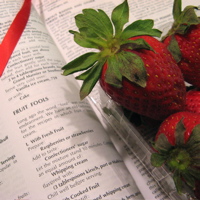 Whew! I made it to the end of April Fools’ Day without falling for any crazy practical jokes. Considering how easily I usually walk into pranks, it’s a minor miracle. (It probably helps that the only person I saw all day was my sweet guy, whose own brand of humor is more clever than cruel.)
Whew! I made it to the end of April Fools’ Day without falling for any crazy practical jokes. Considering how easily I usually walk into pranks, it’s a minor miracle. (It probably helps that the only person I saw all day was my sweet guy, whose own brand of humor is more clever than cruel.)
We spent the day getting the downstairs rooms back in shape — no mean feat considering that they were inhabited by the two of us and two dogs for three months, with very limited storage to begin with. We also swapped the spaces that we use for our offices, which required a trip to Home Depot and Best Buy.
Big-box stores make me itch, so after visiting two in a single afternoon, I really felt like we deserved a treat. We were both so exhausted, there wasn’t a spare drop of energy for elaborate desserts. But we had a pint of strawberries, and a carton of cream… and a quick perusal of Joy of Cooking turned up an all-too-appropriately named dessert that even a fool could master.
Berry Fool
1 pint strawberries
1T superfine (baker’s) sugar
1/2 pint heavy cream
3T ruby port
Rinsed, dry, top, and quarter the berries. Place in a large bowl and sprinkle with the sugar; set aside. Meanwhile, whip the cream with the port until soft peaks form. Stir the sugared berries into the whipped cream, and refrigerate well before serving.
dessert, holidays & occasions, recipes, wine & bubbly
1 Comment »




Posted by Anita on 03.20.07 5:40 AM
 I feel so cosmopolitan: Arriving home from a week in New York City, I found on my desk an envelope postmarked Paris. Ooh la la!
I feel so cosmopolitan: Arriving home from a week in New York City, I found on my desk an envelope postmarked Paris. Ooh la la!
What a pleasant surprise to find inside not one but three trés jolie postcards, and a letter from Amanda at Postdoc in Paris. A-ha — It was my long-lost food-blogger Valentine!
Amanda mentions that the event led her to our blog for the first time, which is one of the things I love about these kinds of events. Now I, too, have another blog in my reader, and a window into a world of someone — a food-loving polymer chemist! — whose blog I doubt I would have simply stumbled across.
Thanks again to Meeta for hosting this fun event.
holidays & occasions, other blogs
1 Comment »




 When DPaul asked me to tend bar at Sean‘s birthday cocktail party, I jumped at the chance. All the fun of planning and serving drinks to our friends, but none of the mess? Sign me up! In all honesty, it seemed a simple enough assignment. My only limitations: Neither Sean nor Paul is a fan of gin (something we’re planning on addressing next year), and Sean has a well-known horreur of orange.
When DPaul asked me to tend bar at Sean‘s birthday cocktail party, I jumped at the chance. All the fun of planning and serving drinks to our friends, but none of the mess? Sign me up! In all honesty, it seemed a simple enough assignment. My only limitations: Neither Sean nor Paul is a fan of gin (something we’re planning on addressing next year), and Sean has a well-known horreur of orange.








 Dia de Los Muertos, or the
Dia de Los Muertos, or the 













 “I got nasty habits, I take tea at three
“I got nasty habits, I take tea at three But the meal that I was not-so-secretly looking forward to the most was dinner at
But the meal that I was not-so-secretly looking forward to the most was dinner at  Last Saturday, we enjoyed a pre-Easter dinner with our friends
Last Saturday, we enjoyed a pre-Easter dinner with our friends  The gorgeous soup we served for
The gorgeous soup we served for  Whew! I made it to the end of April Fools’ Day without falling for any crazy practical jokes. Considering how easily I usually walk into pranks, it’s a minor miracle. (It probably helps that the only person I saw all day was my sweet guy, whose own brand of humor is more clever than cruel.)
Whew! I made it to the end of April Fools’ Day without falling for any crazy practical jokes. Considering how easily I usually walk into pranks, it’s a minor miracle. (It probably helps that the only person I saw all day was my sweet guy, whose own brand of humor is more clever than cruel.)